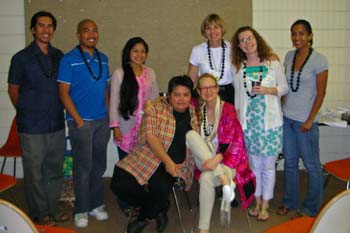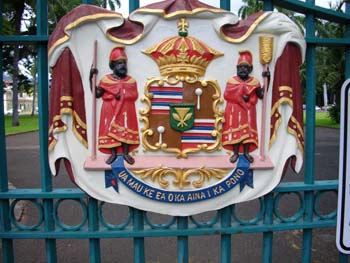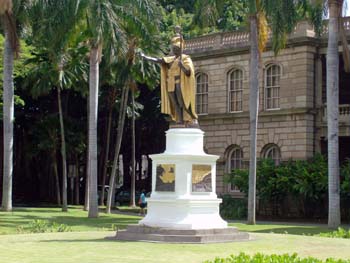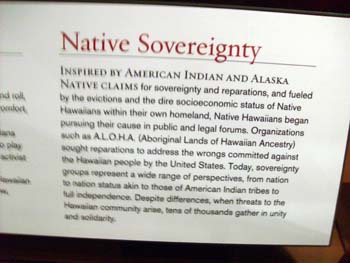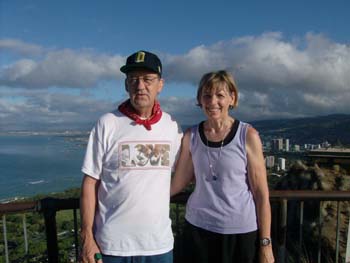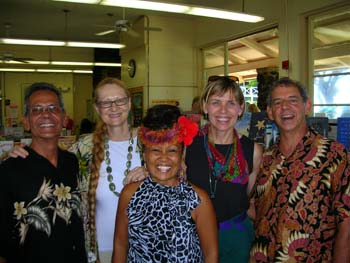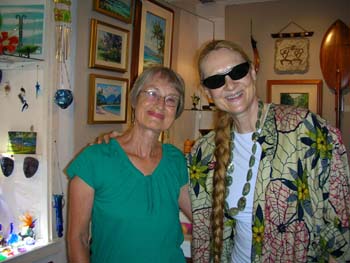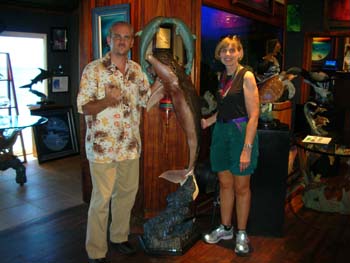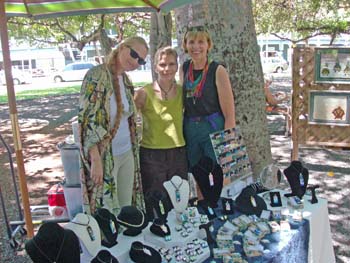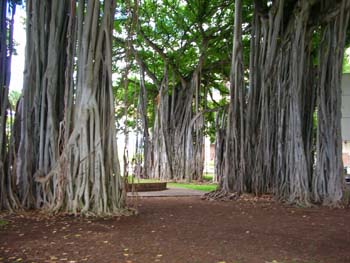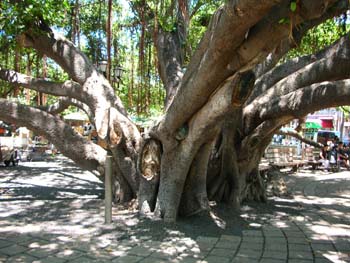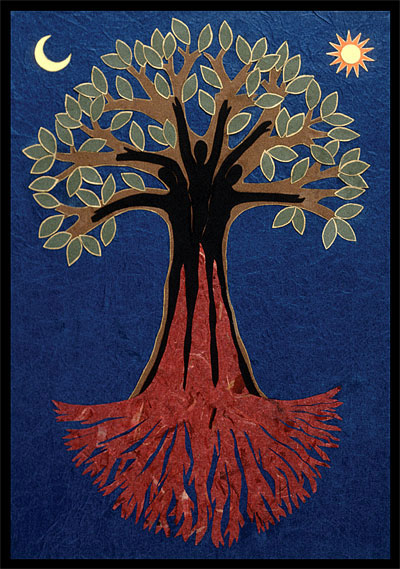Newsletter Nr. 13 (August 2009, subsequent to our 13th Annual Conference of Human Dignity and Humiliation Studies in Hawai'i 20th-22nd August 2009)
Compiled by Linda M. Hartling and Evelin G. Lindner, in Hawai'i (August 2009)
Contents
• Pictures
• Thanks!
• Papers
• Post-Conference Reflections on Passion, Participation, and Business Schools
• Announcements and Good News
• Welcome Again!
Pictures
See a Photo Album of all of the Conference, in Pdf format for downloading, made by Linda Hartling. Thank you, dear Linda!
(Important note to our conference particants: During our conferences, we always make an effort to ask for your permission to have your pictures posted on this website. However, you may have overheard or misunderstood our question, or you may have changed your mind since, either in total or for specific pictures/videos, please let us know! Thank you! Since we wish to walk the talk of dignity, it is very important for us to do our utmost in respecting everybody's privacy. We refrain from gathering written permissions from you during our conferences, since we value the building of mutual trust in relationships, and we also would like to refrain from contributing to an ever more bureaucratic and legalistic society.)
Day One, 20th August 2009 |
|---|
From Evelin's camera Please click on the picture above or here to see more photos! Please see here the video of Day One taped by Stephanie Heuer |
From Linda's camera The venue of our conference - Shidler College of Business (conference venue) and Abraham Lincoln Hall (where many of us stayed) Please click on the picture above or here to see more photos! |
|
From Evelin's camera |
From Linda's camera Our 13th Annual HumanDHS conference was unique in that it took place in a 'nation within' or in a nation that was incorporated into another nation against its will. We watched the deeply troubling film Nation Within on the eve of the 21st August. The 21st of August 2009 (Day Two of our conference) marked the fiftieth anniversary of President Dwight D. Eisenhower signing the Proclamation for Hawai'i to become a State of the United States. This is a controversial anniversary, because the native Hawai'ians consider the annexation an illegal overthrow of their monarchy. This is another example of anniversary celebrations being perceived as profoundly humiliating by those who were disenfranchized. Please see for more information, among others, Hawai'i Pono'ī -The People Who Love the Land. Through Kristabelle Munson, we had the unexpected privilege of witnessing the solemn chanting marking the date of this humiliation, and meeting with Yuklin Aluli, Attorney at Law, and Kau'i N. Burgess, both part of the Hawai'i Pono'ī Coalition. On their website we read: 'Hawai'i Pono'ī is the title of the Hawai'i national anthem written by King Kalākauwa in 1874. Literally translated 'Hawai'i's own', Hawai'i Pono'ī connects us to the history of the Islands and the heritage of its Indigenous people, a heritage that enriches us all. The Hawai'i Pono'ī Coalition was formed to educate those who live in and visit the Islands about Hawai'i's true history, the Native Hawai'ian people, and the culture that makes Hawai'i a place like no other. Kristabelle also made us aware of the Hawai'ian renaissance and of singers such as Gabby Pahinui. See here the lyrics of a song that expresses feelings of sadness at modern alienation, entitled Hawai'i 78 by Israel Kamakawiwo Ole'; see also http://www.youtube.com/. 2014: • "Most people would say that the United States of America has 50 states, and that Hawai'i is one of them. But Hawaiian academic Dr. Keanu Sai says otherwise. Sai says that Hawai'i was never legally annexed to the United States, and has been illegally occupied for the past 121 years," "Dr. Sai interviewed on The Wire in Aotearoa," Hawaiian Kingdom Independence Blog, Hawaii… an independent country under prolonged illegal occupation, 30th September, 2014. • "Hawaiian Sovereignty & International Law by David Keanu Sai Ph.D.," published on 9 Jan 2014. • The sovereignty of Hawai'i: A quote from senior Law Professor Chang: "The power of the United States, over the Hawaiian islands, and the jurisdiction of the United States in the State of Hawai'i, by its own admissions, by its own laws, doesn't exist. And so that means that ever since the 1898 annexation of Hawai'i, by a Joint Resolution, they say, we have been living a myth." (3:01 min/sec.)." • Sai, David Keanu (2008). American Occupation of the Hawaiian Kingdom: Beginning the Transition from Occupied to Restored State. Manoa, HI: University of Hawai`i at Manoa, Political Science, doctoral dissertation. Please click on the picture above or here to see more photos! |
From Evelin's camera Please click on the picture above or here to see more photos! |
Day Four, 23rd August 2009, excursion into O'ahu led by Kristabelle Munson, with Linda and Rick, Safa, Victoria, Grace, Werner, and Evelin |
From Evelin's camera Dear Kristabelle gifted leis from Aunty Dora to us! Lei making has an immediate association with Aloha, and a bona fide importance in Hawai'i's culture. In the inflight magazine of Go! (styled as go!), a regional brand of Mesa Airlines based in Honolulu, Hawai'i, Aunty Dora is featured: 'Aunty Dora is one of the many lei fabricators still stringing together Aloha, and has been for past 74 year. Question to her: What is your name, what do you do and how are you preserving our culture? She replies: I'am 88 years old and make leis. I've been selling leis since I was 14 at the Aloha Tower; from there we had a lei stand at the Keehi (Lagoon) Park. Then they moved us inside the airport and now we are here. Question: How do you define Aloha, and why does it play such an important role? Answer: Aloha means a lot of things, usually Hello, Good-bye, and Love. Question: What is your favorita thing about living in Hawai'i (restaurants, shopping, bars, recreational activities)? Answer: Oh! I've been here my whole life! I just stay here at the lei stand now. I like the weather. Question: When you think of Hawai'i, what song comes to mind? Answer: Beautiful Kauai. Question: Do you have any words of wisdom? Answer: Lei making will never be replaced by machines, they've tried, but it didn't work' (Kama'aina: nvi, native born, born in a place, host.) Please click on the first picture above or here to see more photos of our excursion, and click on Aunty Dora's pictures to see them larger! |
From Evelin's camera Please click on the picture above or here to see more photos! |
From Linda's camera Please click on the picture above or here to see more photos! |
Day Five, 24th August 2009, exploring O'ahu, Linda, Rick, and Evelin |
From Linda's camera Please click on the picture above or here to see more photos! |
Day Seven, 26th August 2009, exploring O'ahu, Linda, Rick, and Evelin |
From Linda's and Evelin's cameras We re-visited the Iolani Palace where we had witnessed the chanting on Day Two. See also many pictures of trees in the palace park further down. In the park, we visited the site of the first royal mausoleum and crypt built in 1825 to house the remains of King Kamehameha II and Queen Kamamalu, who died in England in July 1824. This site was used as a royal tomb until 1865. On the other side of the road is the statue of King Kamehameha I. At the end of our day we visited the Bishop Museum. Please click on the picture above or here to see more photos! |
Day Eight, 27th August 2009, exploring O'ahu, Linda, Rick, and Evelin |
From Linda's camera Linda and Rick climbed Diamond Head in the early morning Please click on the picture above or here to see more photos! |
From Linda's and Evelin's cameras Pearl Harbour: this is a place where the tragedies entailed in the Security Dilemma becomes painfully visible. Please click on the picture above or here to see more photos! |
From Linda's and Evelin's cameras Linda, Rick, and Evelin 'claiming commons'! Waikiki, Royal Hawai'ian and Moana Surfrider Hotel, where we saw the artist Makana! Please click on the picture above or here to see more photos! |
Day Nine, 28th August 2009, exploring Maui, Linda, Rick, and Evelin |
From Linda's and Evelin's cameras With Napua in Keanae, Maui, after we have given up trying to reach Hana! Please click on the picture above or here to see more photos! |
Day Ten, 29th August 2009, exploring Maui, Linda, Rick, and Evelin |
From Linda's and Evelin's cameras Among the most impressive moments of our time in Hawai'i, and extremely significant for our work was our meeting withPrincess Lehu'anani. She teaches native Hawai'ian values or NaHaVas: Ohana - Family, Aloha - unconditional Love, Ha - breath of Life, Kuleana - Responsibility, Ho'ihi - Respect. Please click on the picture above or here to see more photos of the entire day we spent in Maui. Apart from pictures with Princess Lehu'anani, her partner, and their friend and colleague Maury King, you see the following texts: • History of Hawai'i:Ca. 500 A.D., large ocean canoes carrying perhaps 200 people from the Marquesas Islands 1,500 miles south of Hawai'i settled the Big Island first. Several expeditions made the hazardous trip bringing domestic animals and food plants. They lived 53 generations in which no man was made chief over another. Circa 1200: A small group from Tahiti arrived. All Hawai'ian nobility can trace their origins back 40 generations back to this arrival and Pa'ao, the first chief to build a heiau, initiate human sacrifice, and kapu laws. 1788: Captain Cook arrives. Ca. 800,000 people live on the 8 major Hawai'ian islands. 1790: Kamehameha of the Big Island defeats Maui forces in the Battle of Iao Needle, using Western cannon. 1795: Battle of Maui and Oahu: Kamehameha I defeats Maui's King Kalanikupule with 6,000-canoe force, consolidating his kingdom except Kauai. • The Brick Palace of Kamehameha: Kamehameha built the palace for his favorite wife, Queen Ka'ahumanu, but she preferred an airier grass house built nearby. • The King's Taro Patch: In young King Kamehame III's time, it was said that he worked this field himself to demonstrate the dignity of labor. • Here is the famous place, Moko'ula. In ancient times, Moko'ula was a small island located in the center of Mokuhinia fishpond. From the time of Pi'shani until the time of Kamehameha III, the great chiefs of Maui lived on this revered island. At one time, the Mausoleum of the sacred chiefesses Keopuolani and Nahi'ena'ena was maintained here. Because of its close association with the ancient high chiefs of Maui, one should treat this beloved area with the utmost respect. Donated by the Po'okela Council of the Ka'anapoli Beach Hotel. |
From Linda's and Evelin's cameras |
19th August 2009, 'Day Zero', Linda, Rick, Stephanie, and Evelin |
From Evelin's camera Please click on the picture above or here to see more photos! |
| The amazing trees of Hawai'i! |
The trees of Hawai'i: trees live in communities - their roots are intertwined and sometimes these roots are visible! Please click on the picture above or here to see more photos from Linda's and Evelin's cameras! |
5th September 2009, Linda, Rick, and Evelin celebrate six amazing weeks together! |
September 5, 2009, Linda, Rick, and Evelin celebrate six amazing weeks together! In five weeks we lived through and experienced: 2 conferences (Hollyhock and Honolulu), 6 islands in 2 countries, 7 ferries/boats, 4 flights, 4 cars, 8 lodgings, 1,25 palaces, 1 princess... Please click on the picture above or here to see more photos! |
Dear Friends! Thanks!
We had a wonderful conference in Honolulu, Hawai'i!
Linda and I took another two days to wrap up our conference by writing this newsletter. We invite comments and thoughts both from the participants, and from those who were with us in spirit! And please send us your pictures to upload! And if you could help us find a way to upload our videos, we would be very thankful! We have two shorter clips by Stephanie Heuer, and longer taping by Rick Slaven.
Our 13th Annual HumanDHS conference was unique in that it took place in a 'nation within' or in a nation that was incorporated into another nation against its will. We watched the deeply troubling film Nation Within on the eve of the 21st August.
The 21st of August 2009 (Day Two of our conference) marked the fiftieth anniversary of President Dwight D. Eisenhower signing the Proclamation for Hawai'i to become a State of the United States. This is a controversial anniversary, because the native Hawai'ians consider the annexation an illegal overthrow of their monarchy. This is another example of anniversary celebrations being perceived as profoundly humiliating by those who were disenfranchized. Please see for more information, among others, Hawai'i Pono'ī -The People Who Love the Land. Through Kristabelle Munson, we had the unexpected privilege of witnessing the solemn chanting marking the date of this humiliation, and meeting with Yuklin Aluli, Attorney at Law, and Kau'i N. Burgess, both part of the Hawai'i Pono'ī Coalition. On their website we read: 'Hawai'i Pono'ī is the title of the Hawai'i national anthem written by King Kalākauwa in 1874. Literally translated 'Hawai'i's own', Hawai'i Pono'ī connects us to the history of the Islands and the heritage of its Indigenous people, a heritage that enriches us all. The Hawai'i Pono'ī Coalition was formed to educate those who live in and visit the Islands about Hawai'i's true history, the Native Hawai'ian people, and the culture that makes Hawai'i a place like no other. Kristabelle also made us aware of the Hawai'ian renaissance and of singers such as Gabby Pahinui.
Linda, Rick, and Evelin later (29th August, see pictures above) met Princess Lehu'anani in a small local library in the town of Lahaina on Maui, which was the first capital of the Kingdom of Hawai‘i. In her presentation, Princess Lehu'anani described the 'practices of a Hawai'ian', and the 'spirit and practice of aloha' as follows:
1. 'being aware of others and recognizing that there is value in everyone',
2. 'developing a feeling for another's needs, having the sensitivity and awareness to assist without being asked'
3. 'not pushing another down to pull yourself up'
4. 'forgiving a person who has injured you, and then dropping the issue permanently'.
Please let us begin by sharing with you our deep gratitude to all who joined us in making this a special and memorable conference. Everyone participated by not only offering special presentations but also engaging in stimulating and thought-provoking conversations.
We are especially grateful to our host, organizer and co-convener, Dharm P.S. Bhawuk, Professor of Management and Culture and Community Psychology at the Shidler College of Business, University of Hawai'i, Manoa, Honolulu. We are deeply grateful for his leadership and support prior and throughout our conference. All he did, from his wonderful comments and his loving presence to the amazing food he got for us, we are absolutely blown away!
More thanks go to Kristabelle Munson. She gave our entire conference a profoundly meaningful frame. Her knowledge of the history of humiliation of native Hawai'ians was crucial to the overall spirit of the conference. Not only that, Kristabelle also contributed to the discussions and activities in numerous ways. For example, she brought to us the Mahalohalo Kolintang Ensemble, whose music touched us deeply. We have no words to thank Kristabelle, together with Wayland Quintero and his wife Desiree A. Seguritan, Leila Lagundino, and Bernard Ellorin (see here his teacher's website).
Richard Slaven deserves our special gratitude. He always stays in the background, very humbly, while making major contributions. He is the compassionate 'invisible hand' that is crucial for our conferences. This year, this 'invisible hand' included, among others, video-taping our presentations and helping us with the timing! Yet, what would our conference have been without his humorous-relational hugs! The care and love that Rick invests in the relationships, always make our meetings very special.
Stephanie Heuer's contributions are too many to count. She has supported our work over the years in so many ways that it is hard to find words to thank her. We hope to make her wonderful video-tapings available to you soon! We admire the amazing path Stephanie has walked since she first became part of our network. We wish you, dear Safa, all the strength you need for your upcoming doctoral project!
The Indian food that Gokul made for us on Day Two and Day Three was wonderful! Thank you dear Gokul! His telephone number is +1 808 285 4246, and his email ramayan44[@]hotmail.com.We want to furthermore thank Glenn D. Paige, George Kent, Uichol Kim, Rosita Albert, Ya'ir Ronen, Grace Feuerverger, Victoria C. Fontan, Moira R. Rogers, Reinhard Wolf, Werner Schirmer, and Garry Davis for their breathtaking excellence in scholarship, intellectual insights, and their deep passion for taking action and building relationships!
Our conferences involve a commitment to relationship building and engagement, not just as researchers or practitioners but also as human beings. This is what we mean by developing the roots and the trunk of the tree of our work! The trunk is held together by relationships. All of you did a magnificent job in presenting yourselves in ways that encouraged engagement. This is among the most important parts of the process. We are so grateful for your courage, because it is not always easy to step out of the security of conventional academic conference models and jump into the stream of uncertainty associated with a living dialogue.
This conference brought together a diverse array of thoughts and practices. All participants contributed as leaders in their fields, as trees in their own account so-to-speak, and at the same time as branches on our tree of Human Dignity and Humiliation Studies. Trees live in communities!
Thank you for making this conference such a special experience of collaboration, co-creation, and meaningful connection!
The idea was aired at the end of our conference to create an edited book that brings together the various topics of our conference, topics that all speak to dignity and humiliation. We invite you warmly to take this idea and develop it! Who would wish to serve as editors together with dear Linda?
A very warm thank-you to ALL!
There are no words to express our appreciation for your amazing contributions!
Linda & Evelin, on behalf of our entire network, Hawai'i, August 2009.PS: See here the lyrics of a song that expresses feelings of sadness at modern alienation, entitled 'Hawai'i 78 Introduction' by Israel Kamakawiwo Ole'; see also http://www.youtube.com/.
UA MAU KE EA O KA 'AINA I KA PONO O HAWAI'I
(rough translation: The constant, wet Rain Gives Life to the land
and brings goodness/change to Hawai'i)
If just for a day our king and queen
would visit all these islands and saw everything
How would they feel about the changing of our land
Could you just imagine if they were around
and saw highways on their sacred grounds
How would they feel if they 'bout this modern city life
Tears would come from each others eyes as
they would stop to realize
that our people are in great, great danger now
How would they feel
would their smiles be content
rather then cry
cry for the gods, cry for the people
cry for the lands that were taken away
and in it you'll find Hawai'i
Could you just imagine if they came back
and saw traffic lights and railroad tracks
How would they feel about this modern city life
Tears would come from each others eyes as
they would stop to realize
that our land is in great, great danger now
All of the fighting that the king had done
to conquer all these islands
now there's condominiums
How would he feel if saw Hawai'i now
How would he feel
would his smiles be content
rather then cry
cry for the gods, cry for the people
cry for the lands that were taken away
and in it you'll find Hawai'i
UA MAU KE EA O KA ?AINA I KA PONO O HAWAI?
Papers
Feuerverger, Gracer (2009)
On the Child's Right to Identity, the Best Interests of the Child and Human Dignity
An Excerpt from Chapter Three of Teaching, Learning and Other Miracles (2007, Rotterdam: Sense), “What I learned from my first day of Kindergarten” presented at the 13th Annual Conference of Human Dignity and Humiliation Studies 'World Peace through Humiliation-Free Global Human Interactions', in Honolulu, Hawai'i, August 20 to 23, 2009.Evelin G. Lindner (2009)
Dignity or Humiliation in Economic and Monetary Systems: Can We “Occupy Wall Street” and Transcend the Old Cs (Communism and Capitalism) through Economic Systems of True Inclusion? What about Inclusionism? Or Dignism?
This is a manuscript that has been in progress and has changed almost daily over a period of three years. The first version was presented on August 20, 2009, at the 13th Annual Conference of Human Dignity and Humiliation Studies (HumanDHS) “World Peace through Humiliation-Free Global Human Interactions,” in Honolulu, Hawai’i (August 20-22, 2009), and has been developed further since. This is the last version in form of a paper, dating from October 15, 2011. From October 18, 2011, onward, a book on A Dignity Economy has been developed from this paper.Lindner, Evelin G. (2009)
The World on a Trajectory from Humiliation to Dignity: A List of “Factoids”
Paper prepared for the 13th Annual Conference of Human Dignity and Humiliation Studies (HumanDHS), in Honolulu, Hawai'i, August 20 to 22, 2009.Ronen, Ya'ir (2009)
On the Child's Right to Identity, the Best Interests of the Child and Human Dignity
Abstract presented at the 13th Annual Conference of Human Dignity and Humiliation Studies 'World Peace through Humiliation-Free Global Human Interactions', in Honolulu, Hawai'i, August 20 to 23, 2009.Kent, George (2009)
The Humiliation of Hunger
Paper presented at the 13th Annual Conference of Human Dignity and Humiliation Studies 'World Peace through Humiliation-Free Global Human Interactions', in Honolulu, Hawai'i, August 20 to 23, 2009.Kent, George (2009, draft of August 9)
Swaraj Against Hunger
Basis for talks in India, in Kota, Jaipur, and New Delhi in 2009.Jann, Marga, and Platt, Stephen (2009)
Philanthropic Architecture: Nongovernmental Development Projects in Latin America
Essay for the 13th Annual Conference of Human Dignity and Humiliation Studies 'World Peace through Humiliation-Free Global Human Interactions', in Honolulu, Hawai'i, August 20 to 23, 2009.Reich, Wendelin, Schirmer, Werner, and Hamann, Linda (2009)
The Folk Concept of Respect
Unpublished working paper, Department of Sociology, Uppsala University, Sweden: Paper presented at the 13th Annual Conference of Human Dignity and Humiliation Studies 'World Peace through Humiliation-Free Global Human Interactions', in Honolulu, Hawai'i, August 20 to 23, 2009.
- See also:
Reich, Wendelin, and Schirmer, Werner (2009)
A Theory of Respect
Unpublished working paper, Department of Sociology, Uppsala University, Sweden: Work in progress, a shortened version of this manuscript will be presented in the Theory Section at the The American Sociological Association conference in San Francisco in August 2009.Wolf, Reinhard (2009)
Respect and International Relations: State Motives, Social Mechanisms and Hypotheses
Abstract presented at the 13th Annual Conference of Human Dignity and Humiliation Studies 'World Peace through Humiliation-Free Global Human Interactions', in Honolulu, Hawai'i, August 20 to 23, 2009.Uichol Kim (2009)
The Role of Human Dignity in Promoting Creativity, Knowledge and Peace: Humiliation as a Basis for Dehumanization, Conflict and Destruction
Paper presented at the 13th Annual Conference of Human Dignity and Humiliation Studies 'World Peace through Humiliation-Free Global Human Interactions', in Honolulu, Hawai'i, August 20 to 23, 2009.
Post-Conference Reflections on Passion, Participation, and Business Schools
Post-Conference Reflections on Passion by Linda Hartling and Evelin Lindner
After our conference, we began to ask the following questions: When does passion become antagonism? When do emotions cloud clear analysis? Is there rationality without emotions?
These are our reflections: Emotions can be used constructively but they can also be abused. They can help make an argument, but they can also be abused to manipulate people.
Throughout history, the potential of emotions for abuse has been addressed by vilifying them and trying to remove them from human affairs (see for a discussion of this point, among others, Chapter 8 of Lindner's Emotion and Conflict, 2009). We believe that this is a misguided strategy. New research shows that rationality cannot exist without emotions. We learn from Joseph P. Forgas that 'individuals who suffer certain kinds of brain damage to the prefrontal cortex that impairs affective reactions but leaves cognitive capacities intact tend to make disastrous social decisions, and their social relationships suffer accordingly, even though their intellectual problem-solving ability may be completely normal” (J. P. Forgas, 'Introduction: Affect and Social Cognition', in Handbook of Affect and Social Cognition, edited by J. P. Forgas, Mahwah, NJ: Erlbaum, 2001, pp. 1-24, p. 3).
During the past ten millennia of 'dominator societies', as Riane Eisler labels them, male anger was honored as 'rational' investment in Realpolitik, while female emotion was derided as weak 'emotionality' (S. A. Shields, Speaking From the Heart: Gender and the Social Meaning of Emotion, Cambridge, MA: Cambridge University Press, 2002). Emotion and Conflict (2009) was written by Lindner with the aim to help undo this bias. In our conferences, we attempt to circumvent this bias.
“The emotions are now on the agenda because literally there is nowhere else to go. Researchers turned to cognitivism when behaviourism failed to satisfy. Now cognitivism is at a dead end unless it can take emotions on board. Thoughts need feelings to even be real or effective as thoughts” (P. Stokes, Homo Gubernator: Emotions and Human Self-Steering, Dublin: Department of Sociology, University College Dublin, unpublished manuscript, 2005, p. 2).
As Linda Hartling formulates it, we cannot walk the talk of human dignity by using tools of the masters, which is uncritical passion or rigid rationality. Both can be used to manipulate and intimidate. There is no either/or: rationality versus passion is a false choice. This resonates with the point made during the conference that the Cartesian concept of self is not relational enough and needs to be informed by Eastern concepts of relational being.
Bringing dignity into the world means bringing people into right relationships, which is a middle path integrating passion with rational thought. Jean Baker Miller and relational-cultural theory talk about 'feeling-thoughts', which is the integration of emotion and critical thinking: '...feeling-thouhgts help to create better connection - which would in turn lead to more action and empowerment' (J. Baker Miller, Connections, Disconnections, and Violantions', in Feminism and Psychology, 18 (3), pp. 368-380, 2008, p. 372).
George Kent's conceptualization of 'rings of responsibility' provides a path to right relationships where people are dignified and mutually empowered. Kent visualizes concentric circles, moving from the smallest unit of the family, up to the level of the global community. When lower levels fail their responsibility, higher levels have to step in. George Kent concluded his talk on the problem of world hunger by saying that there is no lack of expertise, but lack of caring, and that also the global community has a responsibility to care. Indeed, the global community needs to share the responsibility of caring.
This is also the reason for why we, as the HumanDHS network and in our conferences, make an effort to be as globally inclusive as we can, since we wish to emphasize the need for the global community to share the responsibility of caring.
As to the kind of caring, our network member Arie Nadler highlights the fact that help can humiliate. Therefore it is of utmost importance to qualify and define what caring means and should entail. Satyāgraha is perhaps a suitable term, again linking up with George Kent's India-related paper 'Swaraj against Hunger' (2009). Gandhi’s satyāgraha (non-violent action) is a term that is assembled from satya (truth-love) and agraha (firmness/force). Satyāgraha suggests that practices can be rejected while respecting the people who engage in these practices. Satyāgraha suggests understandig without condoning (Chapter 6 in Lindner's Gender, Humiliation, and Global Security, 2009).
Arne Næss, among the most renowned Norwegian philosophers, said 'There are no murderers; there are only people who have murdered.” He explained this point at the 2nd Annual Conference of Human Dignity and Humiliation Studies, September 12-13, 2003, at the Maison des Sciences de l'Homme de l'Homme in Paris. He explained how he used to invite convicted murderers from prison into his philosophy class at Oslo University to demonstrate to his students that even murderers deserve and need to be dignified. He was adamant that only individuals who feel secure in their connection to humanity can admit to a crime, feel guilty and show remorse. As long as people feel less than fully human, there is no reason for them to care that they have hurt others or society.
Nelson Mandela walked the path that Arne Næss describes. After 27 years, some of his prison guards had become his friends. Mandela refrained from vilifying his oppressors. He could have walked the path of Rwanda, where former subalterns (Hutu means 'servant') attempted to kill their former superiors in a genocide.
Individual charismatic leaders are often seen as the heart and soul of many social movements. We have a different view. 'Never doubt that a small group of thoughtful, committed citizens can change the world. Indeed, it is the only thing that ever has' is a quote attributed to Margaret Mead. Rather than depending on a passionate individual, we strive to create passion throughout our community.
The guiding principle of our work is unity in diversity. Unity in diversity can be operationalized by George Kent's layered notion of rings of responsibility that allow us to integrate passionate action with empathic rationality. Further, we very much agree with George Kent's application of the subsidiarity principle - meaning that local decision-making and local identities are retained to the greatest extent possible - which allows for the optimal structuring of a world of relationships that support unity in diversity.
We also agree with Shibley Telhami, Anwar Sadat Professor for Peace and Development at the University of Maryland, who advocates the building of bridges from academia as follows: 'I have always believed that good scholarship can be relevant and consequential for public policy. It is possible to affect public policy without being an advocate; to be passionate about peace without losing analytical rigor; to be moved by what is just while conceding that no one has a monopoly on justice'.Post-Conference Reflections on Going Beyond Unwitting Assumptions in Dialogue by Linda Hartling and Evelin Lindner
In our conferences we try to circumvent the problem of unwitting assumptions. These assumptions can distort our views and create feelings of humiliation. Uichol Kim and Victoria Fontan both spoke about perceptions and how perceptions depend on context. This can be useful but it can also be misleading. Essentialization, attribution error (fundamental or ultimate), reactive devaluation, false polarization effect - the list is long of biases that entail the potential to lead to serious and even destructive misunderstandings and hamper efforts to solve conflicts, make peace, and dignify a situation. Simplified, we tend to grant ourselves and members of our own group the benefit of the doubt, while we tend to assume the worst from members of other groups. Our assumptions sometimes lead us to dismiss positive behavior by out-group members, merely because they are out-group members.
The reactive devaluation (Ross, Mnookin), for example, and the false polarization effect, turn good ideas into bad ones. Lee D. Ross (July 1997 in Loccum, Germany) explained the experiments that he and his colleagues have carried out at Stanford University on the topic of psychological barriers to conflict resolution, in particular on the reactive devaluation of proposals and concessions: The experiment started with Ross and his colleagues explaining to their American students that a peace offer is put on the table by Ronald Reagan and Mikhail Gorbachev. The researchers then asked whether the students liked the proposal. The results were interesting: the very same idea was valued highly when it was framed as stemming from Reagan, it was rejected when it was framed as coming from Gorbachev. Ross explained that good mediators therefore obscure from where proposals originate. Good mediators not only do shuttle-diplomacy to maintain relationships between the parties, they also actively frame the communication to circumvent reactive devaluation.
In our conferences, we attempt to navigate around 'we-against-them' biases in all their expressions, be it 'we, the Americans against you, the Europeans', or 'we, the academics against you the non-academics', or 'we, from the East against you from the West', or any other polarizations.
We aim at placing the common good of all of humanity at the core of our work. We attempt, as much as we can, to avoid pitting groups against each other. Rather, we hope that we can bring people together to jointly envision a more constructive and cooperative future for humankind.Post-Conference Reflections on Pessimism by Linda Hartling and Evelin Lindner
“Pessimism is a luxury we can afford only in good times, in difficult times it easily represents a self-inflicted, self-fulfilling death sentence.” (Evelin Lindner, and Jo L., Auschwitz survivor, 2004)
One of the metaphors we use for the emergency that humankind finds itself in at the current historical point is MS Titanic (just before sinking, however, still savable by extraordinary effort): In times of crisis, a number of reactions may be expected (simplified): (1) some people may wish to give up and simply enjoy their last days as much as possible (like listening to the music on Titanic while it sinks), (2) some people may be ready to invest all their resources into trying to save the situation from collapse in the spirit of Margaret Mead's above quoted saying (like going to the bridge of Titanic to try to save it from demise), (3) some people may be unsure what to do, (4) some people use 'realistic' pessimism which in effect means denying the emergency. In our conferences, we usually do not meet those who would like to enjoy their last days. We meet, however, those who wish to step up to the challenge of saving the ship.
We would like to call on everybody to recognize that times of emergency are not 'normal' times. The media exploit the drama entailed in conflict, and by doing so risk intensifying conflict instead of working for peace: in 'normal' times, this media approach is perhaps tolerable, whereas in times of crisis, it may cause the situation to tip towards disaster. Similarly, in 'normal' times, 'habitual' perfectionism may be useful. In times of crisis, however, it may contribute to mutual demise. Rescue efforts are not helped when advice is given that is essentially the equivalent of 're-arranging the deck-chairs on the Titanic' independent of the merits of these strategies in normal times. Merely re-arranging the deck-chairs while the Titanic is sinking, risks depleting resources that could be invested more effectively. Moreover, these strategies can obstruct and distract us from truly effective rescue efforts, and thus contribute to the demise of the ship.Post-Conference Reflections on Business Schools by Linda Hartling and Evelin Lindner
The Shidler Business School provided the perfect backdrop for one of the most challenging questions at the conference: How can we develop economic systems that uphold the dignity of all people?
Many discussions were stimulated in response to viewing the DVD Money As Debt by Paul Grignon, and our idea to found a Dignity Bank. The film demystifies the historical development of our existing unsustainable monetary system. It helped us to understand how the profit motive not only distorts economic relationships but also social relationships, affecting global stability, both socially and ecologically.
The guiding principle of our HumanDHS work is unity in diversity. How could this principle help us conceptualize a new, more dignified, economic system? The notions of dignity, respect, and humiliation provide a unifying structure for understanding economic and social injustice:
What if the problem could be conceptualized as follows:
Humiliating economic systems and monetary practices
â
Lead to a dissipation of dignity, respect and trust: humiliation is a profound violation of unity in dignity and respect (these points were illuminated by the contributions by Werner Schirmer, Reinhard Wolf, Linda Hartling, Evelin Lindner)
â
The dissipation of dignity, respect and trust leads to a diverse array of systemic problems, such as systemic killing (Glenn D. Paige), systemic hunger (George Kent), systemically inefficient peace-building initiatives (Victoria Fontan), systemic ethnic conflict (Rosita Albert), systemic educational discrimination (Moira Rogers, Grace Feuerverger, Stephanie Heuer), systemic abuse in the social welfare of children (Ya'ir Ronen), as well as systemic resistance to the core spirit of human rights, namely global citizenship (Garry Davis).
Possibilities for change:
A starting point for new economic arrangements may be to emphasize that respectful relationships should lead rather than follow the development of economic strategies.
As Uichol Kim says:Western cultures emphasize the rational, thinking, inner self. This is portrayed by famous quotes by Socrates ('Know thyself'), Shakespeare ('To be or not to be, that is the question') and Descartes ('I think, therefore I am'). The knowing, thinking and choosing self is the core of Western epistemology. In contrast, the Korean word for human being is ingan, which can be translated literally as 'human between'. It is the same Chinese character that is also used in China and Japan. In other words, it is not what happens within an individual that makes him or her human, but what happens between individuals that is important (Kim, 2001a). For example, Mencius stated that: 'If you see a child drowning and you don't feel compassion, you are not human being. ' It is compassion that helps us to relate to the child and propels us to take the necessary risks to save the child. For this reason, interpersonal emotions and not physiology or biology is viewed as the basis of human psychology. Human essence is basically relational and it can be defined in terms of emotions that people feel for one another. In other words, the essence of self in East Asia can be stated as 'I feel, therefore I am' (Kim, 2001a). Confucianism provides the philosophical basis for articulating and promoting the relational view of self, society and trust (Sang-Chin, C. and U. Kim. 'Emotional Attachment As the Basis of Trust and Interpersonal Relationships: Psychological, Indigenous and Cultural Analysis', Ongoing Themes in Psychology and Culture, edited by Bernadette N. Setiadi, Augustinus Supratiknya, Walter J. Lonner, and Ype H. Poortinga, Melbourne, FL: International Association for Cross-Cultural Psychology, www.iaccp.org, selected papers from the Sixteenth International Congress of the International Association for Cross-Cultural Psychology, 2004).
We realized that we can get caught in false choices and misleading dichotomies, based on out-dated 'we-against-them' dynamics of humiliation, if we, in our discussions, merely reflected a model of 'Western' versus 'Eastern' cultures. To address our global challenges (such as our social, economic, and ecological crises), we need everyone's participation to move toward new arrangements of relationships, socially, economically, ecologically, locally and globally. We need to take the best of all cultures and move together toward new levels of mutuality in all realms of human affairs.
We need to learn the best practices of all cultures, in the spirit of Uichol Kim's example of the 'human between' that resonates, for example, with the relational logic of the African Ubuntu philosophy's 'I am human because of your humanity'. We believe it is important to harvest the dignifying wisdom of all cultures (in a respectful way, not as a superficial 'cherry-picking' of cultural practices).
Unity in diversity is served when we learn from the dignifyng wisdom and practices of all cultures, while celebrating the diversity of how dignity is expressed.
As noted earlier, the idea was aired at the end of our conference to create an edited book that brings together the various topics of our conference, topics that all speak to dignity and humiliation. We invite you warmly to take this idea and develop it! Who would wish to serve as editors together with dear Linda?
Announcements and Good News
See here the latest news of our HumanDHS network!
Next Strategic Level of Our Work
In newsletter 10, we began to use the image of a tree for our work. We used the following picture to illustrate the structure of our network:
Over time, this metaphor has evolved. Trees live in communities. They are often connected through their roots. Hawai'i is particularly well-suited to observe trees that have their web of mutually connecting roots exposed. Our host, organizer and convener, Dharm P. S. Bhawuk, proposed that we can envisage the 'tree' of our network being intertwined with the roots of other, similar initiatives, like the Center for Global Nonkilling in Hawai‘i. We had the great privilege to have its founder Glenn D. Paige speak to us, and Karen Cross, and Katherine Li join us at the end of our conference.
Linda Hartling kindly wrote (October 30, 2009): 'Also, I recently read a biography about Mahatma Gandhi's nonviolent movement and came across this wonderful little description of the Banyan tree, a important symbol of this effort: 'Banyan: A tree whose aerial roots grow down into the soil to form additional trunks. The banyan...can grow to an immense size and often serves as a focal point for meetings...at the centre of Indian villages'.We try to express the principle of unity and diversity and the rings of responsiblity that George Kent spoke about not only in the way we structure our conferences, but also in the way we structure our network, both offline and online. All our network members are invited to help build the unifying relationships that are needed to make the 'roots and trunk' of the tree strong, and all are invited to create a wide and rich diversity of branches on our tree.
Linda found this very evocative image of a tree entitled 'Mother Root' by Jan Richardson
1998 from his book In Wisdom's Path: Discovering the Sacred in Every Season (Cleveland: The Pilgrim Press, 2000).
Welcome Again!
We would like to end this newsletter by thanking all conference participants for co-creating a deeply enriching experience. All our network members have been with us in spirit throughout the conference, and we are very grateful for their ongoing encouragement and support.
We warmly invite you all to our next conferences in NY in 2009 and in Istanbul in April 2010!
Linda & Evelin, Honolulu, Hawai'i, August 2009






